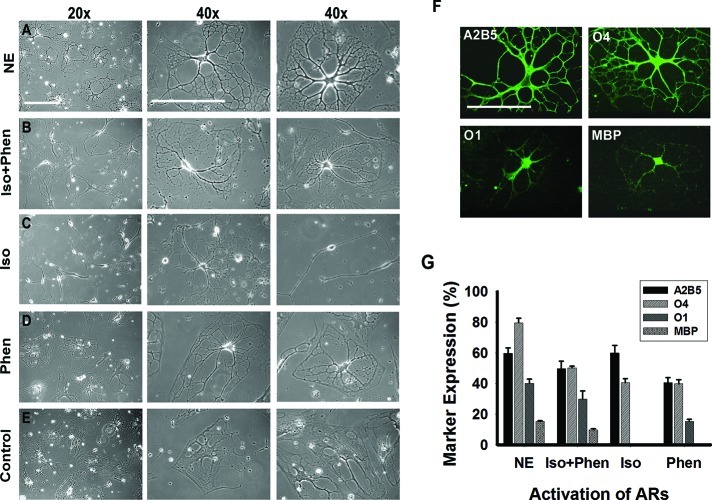Figure 7.
Influence of ARs on differentiation of MLPC into oligodendrocytes. (A) Phase contrast images of cells after differentiation for 30 days, in the presence of NE, that exhibited a complex multipolar morphology. (B) Cells differentiated for 30 days in the medium in which NE was substituted with the β-AR agonist isoproterenol and the α1-AR agonist phenylephrine. Cells were morphologically comparable to cells treated with NE. (C) Cells differentiated in the presence of the β-AR agonist isoproterenol frequently displayed a bipolar morphology, resembling immature oligodendrocyte progenitors. (D) Substitution of NE with the α1-AR agonist phenylephrine resulted in a mature morphology in 10% of cells. The remainder of the cells showed only partial process development or remained flat. (E) Cells differentiated for 30 days without activation of ARs by NE or AR agonists continued to exhibit a mostly flat morphology. (F) Stimulation of both α1- and β1-ARs is required for optimal differentiation. Immunocytochemical analysis of cells differentiated for 30 days in the presence of the β-AR agonist isoproterenol and the α1-AR agonist phenylephrine. Cells stained positively for A2B5, O4, O1, and MBP. Scale bars are 100 μm. (G) Comparison of differentiation levels achieved by activation of both ARs by NE, by both AR agonists (Iso+Phen), by β-AR by isoproterenol (Iso), and by α1-AR agonist phenylephrine (Phen). Error bars represent the SD.

